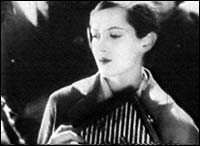| |
 |
|
|
The dream narrative of Mulholland
Drive begins with a raven-haired femme fatale
type played by Laura Elena Harring being driven along the
curvaceous Los Angeles artery Mulholland Drive by night. Instantaneously
the target of a hit, she has a gun to her head when a wildly
fortuitous car crash provides a means of escape. The traumatised
woman is lured towards the endless city lights. Stumbling
down iconic Sunset Boulevard in the early hours, she finds
refuge in an empty apartment on Havenhurst after watching
its owner, a red-haired middle-aged woman, leave in cab. We
will know from a series of calls to several individuals by
an unnamed mobster type that the woman is being pursued :
“The girl is still missing”. Fleeing from the
scene, bloody, bewildered and snow white in the moonlight,
she reminds us of the black-haired Dorothy’s naked, bruised
appearance to Jeffrey in Blue Velvet (1987) following
her flight from the psychopath Frank. Road accidents appear
to intrigue Lynch. In Wild At Heart (1990) too, a bloody
young woman emerges from the wreckage of a car crash. Interestingly,
road accidents occur in Luis Bunuel’s visionary surrealist
classic Un Chien Andalou (1929). A young androgynous
woman is killed by a car in one scene. In another, a young
man falls bizarrely on the same road from his bicycle. Why
road accidents ? Accidents and car crashes constitute
a surreal event in that they perfectly capture the surrealist
attribute of le hasard or le gratuit. (chance
and the gratuitous). Accidents may rupture and disorient the
narrative. They may also direct and engender narrative. As
such, they possess a figurative power. The violent crash on
Mulholland provides a weird, traumatic opening for Lynch’s
tale and ultimately introduces the victim Rita to Betty in
the dream narrative of Mulholland Drive. It sparks
Mulholland’s mystery and love story. Lynch’s obsessive
interest in car accidents also reveal his identification with
surreal eroticism. In surrealism, violence is bound up with
sex. In Un Chien Andalou, the killing of the beautiful
androgynous woman directly feeds the sexual desire
of the watching cyclist (the same cyclist who falls in the
previous sequence) and his female partner. Accidents therefore
provide an intense voyeuristic pleasure. In Mulholland,
Lynch alludes to the surrealist binding of sex and violence
which is also of course an eternal aesthetic fixation in Hollywood.
Indeed, the often violent objectification of women in surrealism
- manifested in fragmented and dismembered female body parts
- is sustained in Hollywood. The vision of beautiful and distressed
Laura Elena Harring in a black cocktail dress stumbling from
the wreck is an image which evinces both a Hollywood necrophiliac
fetish and Sadean surrealism. Through such imagery, Lynch’s
Hollywood is identified a dark “dream place”. The industry
of dreams surreally exhibits the accidental, strange and marvellous.
|